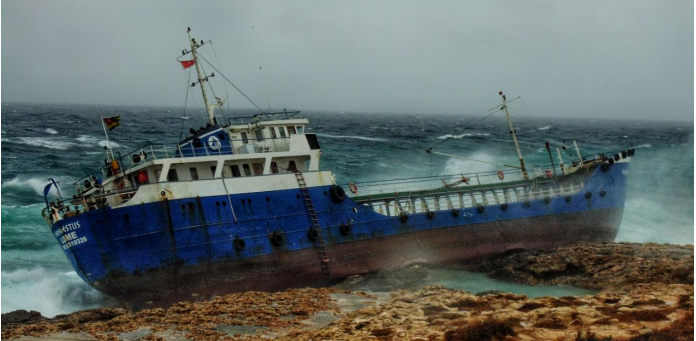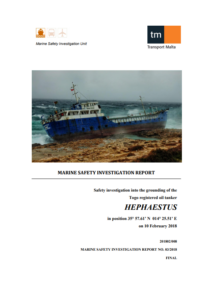Transport Malta’s Marine Safety Investigation Unit (MSIU) issued an investigation report into the grounding of the Togo-registered oil tanker ‘Hephaestus’ in February 2018, after being exposed at anchor for several days in deteriorating weather conditions. The report highlighted lack of visible leadership and commitment towards the safety of the ship and the crew from the company.
The incident
On 10 February 2018, at about 06451, MSIU was notified by Transport Malta officials from the Ports and Yachting Directorate, that the motor tanker Hephaestus had run aground in position 35° 57.61’ N 014° 25.51’ E, limits of Qawra Point, St Paul’s Bay, Malta at about 0615. At the time, the vessel was in ballast condition.
Preliminary information indicated that Hephaestus, which had been at anchor for some days approximately 1.5 nautical miles from the shoreline, in Bunkering Area No. 1, dragged her anchor in Force 8 winds, gusting to Force 10, and eventually went aground.
Some of the ship’s bunkers and/or oily-water from the bilges escaped from the vessel several days after the grounding and eventually booms had to be deployed around the wreck. As a result of the grounding, the vessel sustained extensive structural damages. The seven crew members, who disembarked from the vessel directly on the rocky shore using the vessel’s pilot ladder, reported no serious injuries.
Probable cause
The vessel was at anchor in an exposed position in deteriorating weather conditions which compromised the safety of the vessel and her crew.
Conclusions
- The vessel was on the sudden edge of the bunkering area, close to the shoreline in water depths of 49.0 m;
- Hephaestus did not have enough anchor cable paid out to effectively hold her position in the prevailing inclement weather conditions;
- The master remained in Bunkering Area No. 1 and the position had not been revised with the sudden deterioration of the weather;
- The situation was not considered to be alarming by the master, until the weather deteriorated;
- The master may have misunderstood the communication with the VTS with regards to staying at anchor within Bunkering Area No. 1;
- The vessel’s main engine was ready but the master was not aware;
- In the absence of an operational safety management system, effective management of hazards was compromised;
- Bunkering Area No. 1 at the North was not actively monitored by any of the VTS operators and supervisors;
- When Hephaestus started dragging anchor at around 0515 and consequently drifting in a Southerly direction towards the shoreline, neither the VTS operators nor the supervisor noticed this on their monitors;
- Given that the busiest and most complex areas were competing for the VTS operators’ attention, it would have been rather easy for a change in the status of a solitary ship to be missed;
- The absence of guard zone alarms to alert the VTS operators that the status of Hephaestus had changed was considered to be a missing protective barrier system.
- The NAVTEX onboard was set to print weather forecasts in the Greek language and which was not understood by the master;
- The NAVTEX was not set to receive international messages;
- During the days leading to the accident, there was lack of visible leadership and commitment towards the safety of the vessel and the crew members from the Company;
- The Company’s safety policies, strategies and objectives were neither met nor supported;
- The wind warning had neither been broadcasted by the VTS nor was it clear that this waning has been received by the vessel;
- The port anchor had been lost before it was let go.
Recommendations
Following the investigation, Transport Malta recommended:
- The owner company to engage in a detailed, strategic exercise possibly with the involvement of professionals to ensure that the current safety management structure is assessed, safety issues identified, address the problems related to implementation and ensure that communication and monitoring strategies are in place.
- Transport Malta’s Ports & Yachting Directorate to determine whether VTS Valletta should activate guard zones and / or the Automatic Detection and Alert Triggering of Ship Behaviour service offered by EMSA.
Explore more in the official report herebelow:






























































